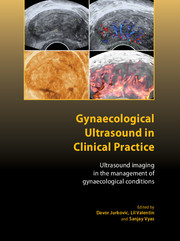 Gynaecological Ultrasound in Clinical Practice
Gynaecological Ultrasound in Clinical Practice Published online by Cambridge University Press: 05 February 2014
Introduction
Anal endosonography is a relatively recent development in the evolution of diagnostic ultrasound. Following the original description of the technique by Bartram in 1989, Sultan et al. clarified and validated the interpretation of images. Subsequently, other approaches were described such as transvaginal and transperineal, allowing imaging of the undisturbed anal sphincter. It is now also possible to obtain three-dimensional ultrasound images as well as magnetic resonance images. Anal endosonography is now regarded as the gold standard investigation in patients presenting with faecal incontinence. It is also useful in the diagnosis of anal pain, anorectal tumours, fistulae, abscesses and anismus. The advent of anal endosonography has enabled considerable research into obstetric related anal sphincter trauma, the major aetiological factor in the development of anal incontinence.
Anatomy of the anorectum
Before any attempt is made to image the anal sphincter it is important to have a clear understanding of the anatomy and normal variation of the anorectal musculature to avoid misinterpretation. However, the precise anatomy of the anal sphincter mechanism has remained controversial and there is still disagreement as to whether the external anal sphincter is composed of one, two or three parts. The three-part classification of the external anal sphincter into deep, superficial and subcutaneous components (Figure 11.1) remains the most popular. These subdivisions are difficult to demonstrate during cadaveric dissections, however, and they are certainly not identifiable during surgery.
To save this book to your Kindle, first ensure [email protected] is added to your Approved Personal Document E-mail List under your Personal Document Settings on the Manage Your Content and Devices page of your Amazon account. Then enter the ‘name’ part of your Kindle email address below. Find out more about saving to your Kindle.
Note you can select to save to either the @free.kindle.com or @kindle.com variations. ‘@free.kindle.com’ emails are free but can only be saved to your device when it is connected to wi-fi. ‘@kindle.com’ emails can be delivered even when you are not connected to wi-fi, but note that service fees apply.
Find out more about the Kindle Personal Document Service.
To save content items to your account, please confirm that you agree to abide by our usage policies. If this is the first time you use this feature, you will be asked to authorise Cambridge Core to connect with your account. Find out more about saving content to Dropbox.
To save content items to your account, please confirm that you agree to abide by our usage policies. If this is the first time you use this feature, you will be asked to authorise Cambridge Core to connect with your account. Find out more about saving content to Google Drive.